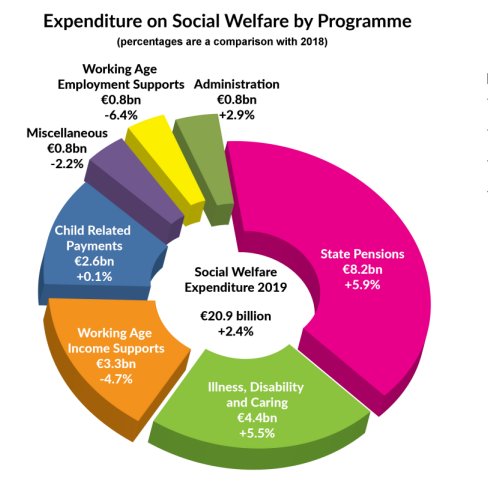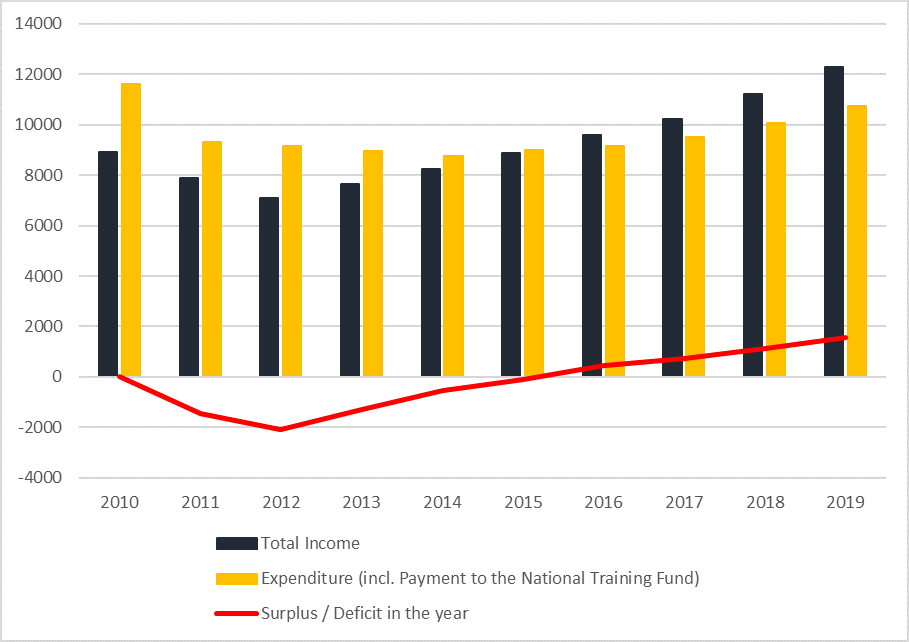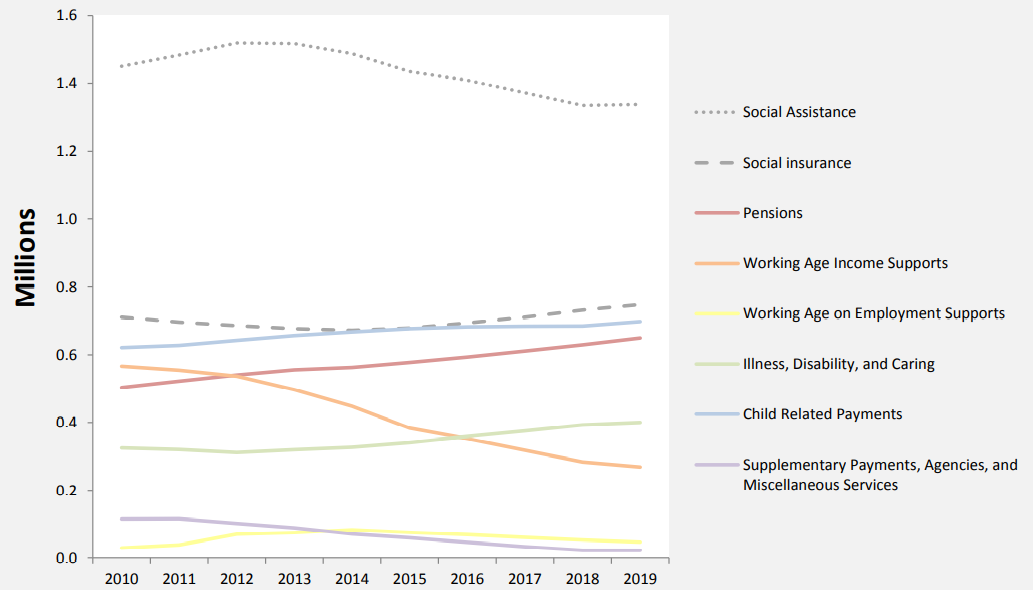Social Welfare Payments, details from the data

Social transfers are an effective policy tool in reducing income inequality in Ireland. Without social transfers, the proprtion of the Irish population living at risk of poverty would be more than double what it currently is. Expenditure by the Department of Employment Affairs and Social Protection accounted for 24 per cent of total Government expenditure in 2019, and 6 per cent of GDP. The Department recently published its Annual Statistical Report 2019 which contains a wealth of information on how this expenditure is distributed.
Social Protection Expenditure
Of the €20.9 billion in social welfare expenditure in 2019, almost four in every ten euro was spent on Pensions (39.3 per cent); one in five was spent on payments in respect of Illness, Disability and Caring (21.3 per cent); Working Age Income Supports accounted for 15.6 per cent; Children accounted for 12.6 per cent; and Supplementary Payments and Working Age Employment Supports accounted for 3.8 and 3.7 per cent respectively (Chart 1).
Chart 1: Expenditure on Social Welfare by Programme

Source: Department of Employment Affairs and Social Protection Annual Statistical Report 2019, p.2
The largest reductions in year on year expenditure were in Working Age Employment Supports (-6.4 per cent) and Working Age Income Supports (-4.7 per cent), while the highest increases were in Pensions (+5.9 per cent) and Illness, Disability and Caring (+5.5 per cent).
Social Protection Income
The main source of revenue for social protection is Employer PRSI, which accounted for over two-thirds of all income (68.4 per cent). Employee PRSI accounts for one fifth (20.2 per cent), and the remaining income mainly consists of Self-Employed PRSI (5.1 per cent), National Training Fund (5.8 per cent), Benefit Overpayment Recoveries (0.9 per cent), Redundancy and Insolvency Recoveries (0.1 per cent); and Recoverable Benefits (0.18 per cent).
Since 2016, social insurance income has exceeded Social Insurance expenditure, with a surplus of almost €1.6 billion recorded in 2019 (Chart 2).
Chart 2: Financing of Social Insurance Fund (€million)

Source: Data extracted from the Department of Employment Affairs and Social Protection Annual Statistical Report 2019, Table A4
Notwithstanding the importance of social transfers in the alleviation of poverty, there remains almost 670,000 people living at risk of poverty in Ireland according to the latest SILC data (2018). This surplus should therefore be invested in initiatives to lift these 670,000 out of poverty.
Social Welfare Recipients
Over 2 million people are in receipt of some form of social welfare payment. The largest proportion of these people are in receipt of Child-related payments (697,162 people, an increase of 12 per cent on 2010), followed by those in receipt of the State pension (almost 650,000 people, an increase of 29 per cent since 2010), and those in receipt of Illness, Disability and Carers payments (almost 400,000 people, an increase of 22 per cent since 2010) (Chart 3). Recipients of Supplementary Payments, Agencies and Miscellaneous Services have decreased by over 86 per cent between 2010 and 2019 (from 115,493 to 15,969), due in large part to a reduction in the number of Rent Supplement recipients following the introduction of the Housing Assistance Payment in 2014 (a reduction from 97,260 recipients in 2010 to 15,913 recipients in 2019) and the termination of Mortgage Interest Suppment (a reduction from 17,974 recipients in 2010 to 0 in 2019). Of the 15,913 recipients of Rent Supplement, some 13,952 are classified as "Long-Term Recipients" and will likely be transferred to the Housing Assistance Payment over time.
Chart 3: Trends in Social Welfare Recipients 2010-2019

Source: Department of Employment Affairs and Social Protection Annual Statistical Report, p.25
Of the 2,847,731 recipients of the main social welfare benefits, including free travel, 2,517,027 (88 per cent) are Irish nationals, 95,083 (3.3 per cent) are UK nationals, 25,164 (0.8 per cent) are nationals of the EU13, 144,115 (4 per cent) are from the EU15 to 28, and 66,342 (2.3 per cent) are non-EU nationals.
Given the importance of social welfare payments to such a large cohort of the population, it is imperative that the model is both sustainable and equitable. Social Justice Ireland has previously proposed a model of indexation of social welfare payments, to an initial 27.5 per cent of average weekly earnings as a move towards securing a minimum standard of living for all. This should be implemented in Budget 2021.